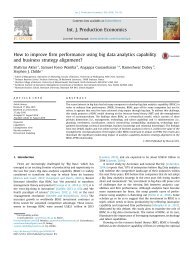Akter, S., Wamba, S. F., Gunasekaran, A., Dubey, R., & Childe, S. J. (2016). How to improve firm performance using BDAC and business strategy alignment.
You also want an ePaper? Increase the reach of your titles
YUMPU automatically turns print PDFs into web optimized ePapers that Google loves.
118<br />
S. <strong>Akter</strong> et al. / Int. J. Production Economics 182 (<strong>2016</strong>) 113–131<br />
Fig. 1. Research Model.<br />
following sections <strong>to</strong> support our Delphi findings.<br />
3.1. BDA management capability (BDAMAC)<br />
BDAMAC is an important aspect of <strong>BDAC</strong> ensuring that solid<br />
<strong>business</strong> decisions are made applying proper management framework.<br />
Four core themes were found <strong>to</strong> constitute perceptions of<br />
BDAMAC; these were termed as BDA planning, investment, coordination,<br />
<strong>and</strong> control. The BDAMAC starts with the proper BDA<br />
planning process which identifies <strong>business</strong> opportunities <strong>and</strong> determines<br />
how the big data-based models can <strong>improve</strong> <strong>firm</strong> <strong>performance</strong><br />
(FPER) (Bar<strong>to</strong>n <strong>and</strong> Court, 2012). For ex<strong>amp</strong>le, Amazon<br />
planned <strong>to</strong> engage a type of predictive modeling technique called<br />
‘collaborative filtering’ <strong>using</strong> cus<strong>to</strong>mer data <strong>to</strong> generate ‘you might<br />
also want’ prompts for each product bought or visited. Amazon<br />
revealed at one point that 30% of sales were generated through its<br />
recommendation engine (Manyika et al., 2011). Similarly, BDA investment<br />
decisions are critical aspects of BDAMAC as they reflect<br />
cost–benefit analyses. For ex<strong>amp</strong>le, Netflix Inc. transformed its<br />
<strong>BDAC</strong> by investing in web data of over one billion movie reviews in<br />
categories such as liked, loved, hated, etc. <strong>to</strong> recommend movies<br />
that optimize the ability <strong>to</strong> meet cus<strong>to</strong>mer preferences (Davenport<br />
<strong>and</strong> Harris, 2007b). According <strong>to</strong> Ramaswamy (2013), “[w]e found<br />
that companies with huge investments in Big Data are generating<br />
excess returns <strong>and</strong> gaining competitive advantages, putting companies<br />
without significant investments in Big Data at risk”. Thus, it<br />
is important <strong>to</strong> manage this capability in order <strong>to</strong> enhance revenue-generating<br />
activities, as have been applied by Netflix, General<br />
Electric, <strong>and</strong> LinkedIn, <strong>to</strong> drive growth. In addition, BDA coordination<br />
receives increased attention in the big data environment,<br />
representing a form of routine capability that structures the<br />
cross-functional synchronization of analytics activities across the<br />
<strong>firm</strong> (Kiron et al., 2014). For ex<strong>amp</strong>le, analysts of Procter <strong>and</strong><br />
Gamble work in coordination across operations, the supply chain,<br />
sales, consumer research, <strong>and</strong> marketing <strong>to</strong> <strong>improve</strong> <strong>to</strong>tal <strong>business</strong><br />
<strong>performance</strong> (Davenport, 2006). Finally, BDA controlling functions<br />
Table 5<br />
RBT <strong>and</strong> entanglement view of sociomaterialism: similarities <strong>and</strong> complementarities <strong>to</strong> support the <strong>BDAC</strong> model.<br />
Theory Key ideas Similarities with the <strong>BDAC</strong> model Complements <strong>to</strong> the <strong>BDAC</strong> model<br />
Resource based theory (Barney, 1991)<br />
Entanglement view <strong>using</strong> sociomaterialism<br />
(La<strong>to</strong>ur, 2005; Orlikowski,<br />
2007; Orlikowski <strong>and</strong> Scott,<br />
2008; Stein et al., 2014)<br />
Resources are valuable, rare, imperfectly<br />
inimitable <strong>and</strong> supported<br />
by organizational structure <strong>and</strong><br />
processes <strong>to</strong> enhance <strong>firm</strong><br />
<strong>performance</strong>.<br />
The relationship between human<br />
<strong>and</strong> material agencies is inseparable<br />
<strong>and</strong> inextricably interlinked.<br />
Similar <strong>to</strong> RBT, <strong>BDAC</strong> relies on the assumptions<br />
of resource heterogeneity,<br />
imperfectly mobile <strong>and</strong> inimitable resources<br />
<strong>and</strong> recognize the importance of<br />
strategic <strong>alignment</strong> <strong>to</strong> leverage the resources<br />
<strong>to</strong> influence superior <strong>firm</strong><br />
<strong>performance</strong>.<br />
The proposed <strong>BDAC</strong> model relies on the<br />
building blocks of hierarchical capabilities<br />
(i.e., management, technology<br />
<strong>and</strong> talent). Similar <strong>to</strong> entanglement<br />
view, all the dimensions of <strong>BDAC</strong> are interlinked<br />
<strong>and</strong> mutually supportive.<br />
Provides an explanation of how big data<br />
organizations enhance <strong>firm</strong> <strong>performance</strong><br />
because, first, they have the required capabilities;<br />
second, they successfully align<br />
analytics capabilities-<strong>firm</strong> strategies;<br />
Provides the logic of how people, systems,<br />
data <strong>and</strong> management are entangled <strong>to</strong> influence<br />
<strong>firm</strong> <strong>performance</strong>. The hierarchical<br />
BDA capabilities are leveraged through their<br />
synergistic ties which are based on complementarity<br />
<strong>and</strong> co-specialization.




